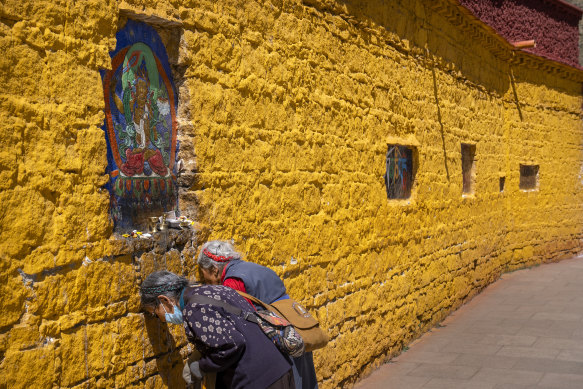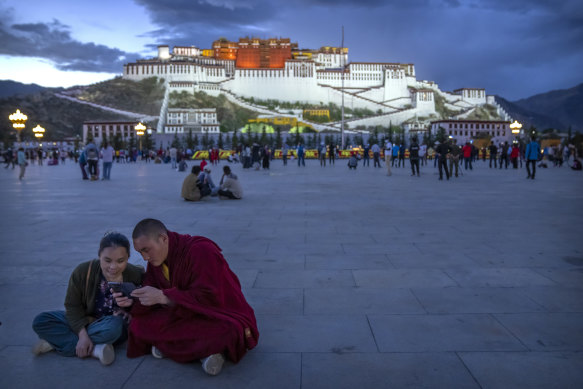Hong Kong: Chinese authorities’ quest to continue wiping out the virus causing COVID-19 have hastily erected three makeshift hospitals in Tibet, after the autonomous region recorded its first cases in the pandemic.
The new facilities provide 2000 beds in the capital, Lhasa, and 1000 in the city of Shigatse. As part of its ongoing COVID-Zero strategy, Beijing mandates that all positive cases and their close contacts be isolated, often in government-built temporary hospitals.
After living most of the pandemic virtually virus free, Tibet reported 28 new cases for Tuesday and has imposed a partial lockdown of Lhasa – including the famed Potala Palace, the traditional winter residence of the Dalai Lamas – while it mass tests its people to root out hidden chains of transmission. A team of health experts from Beijing has arrived to support its containment measures.
Members of the Tibetan Buddhist faithful pay their respects at a holy site at the base of the Potala Palace in Lhasa, Tibet. The Palace is closed due to the first cases of COVID in the region since the start of the pandemic.Credit:AP
China’s National Health Commission warned on Wednesday that people in high-altitude regions were more prone to chronic respiratory diseases and low blood oxygen levels, putting them at greater risk of serious illness from COVID. An analysis of an outbreak in the mountainous province of Gansu, which had 27 serious cases among its almost 4500 infections, suggested the topographical link, official Guo Yanhong told reporters at a briefing.
With the onset of the northern summer holiday season, and its international borders effectively closed, China is grappling with flare-ups in multiple tourism hotspots, and local officials are turning to the COVID-Zero playbook of movement restrictions, mass testing and surveillance to try to get the cases under control. The virus is spreading fast in areas including Xinjiang, Inner Mongolia and Guangdong, according to NHC spokesman Mi Feng. China’s 952 new infections on Tuesday made for the highest tally in almost a month.
A monk and a woman look at a smartphone on a square in front of the Potala Palace in Lhasa, Tibet, as seen during a government organised visit for foreign journalists last year.Credit:AP
In the north-west, Urumqi – the capital city of Xinjiang and a popular destination for Chinese travellers for its proximity to the Silk Road – locked down six of eight major areas for five days, suspending taxi and public transport services. The region reported 122 COVID cases. More parts of Xinjiang were subject to restrictions, officials said, but tourists would now be able to leave the region if they produced a negative PCR test within 24 hours.
China’s largest outbreak is in Hainan, a tropical island in the south known for its beaches and duty-free shopping, where 570 cases were reported. Some travellers who had been stranded in Sanya, a popular tourist spot on Hainan’s southern tip, since flights were cancelled and restrictions imposed last week were able to leave on Tuesday, with more departures expected. Those still there are subject to frequent mass testing and curbs on their movements.
The flare-ups coincide with a rallying call from a top Communist Party newspaper that officials must avoid becoming “slack” and “war weary” when it comes to fighting the virus. The state-run Economic Daily’s front-page commentary on Wednesday noted that, unlike Western countries, China’s approach seeks to prevent deaths and protect people’s health.
The article, which acknowledged pandemic controls were having an impact on people’s lives, followed a meeting of the Politburo last month, where the strict COVID-Zero policy was reinforced by top Chinese leaders. While other countries that pursued virus elimination strategies, such as Singapore and Australia, have moved on from the approach accepting COVID as endemic, China continues to try to snuff out cases, leaving it isolated as the rest of the world lives alongside the virus.
Bloomberg
Most Viewed in World
From our partners
Source: Read Full Article

